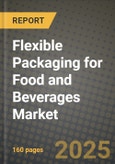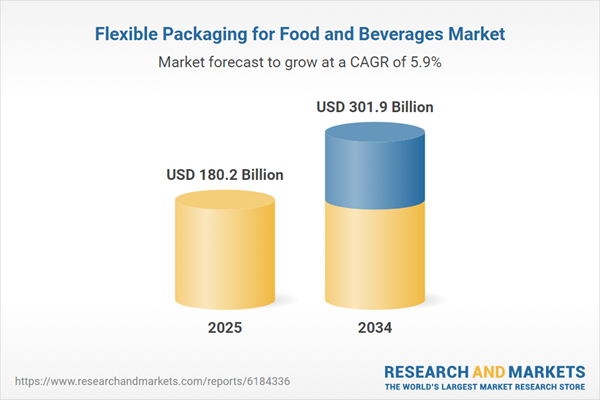Flexible Packaging For Food and Beverages Market
The Flexible Packaging for Food & Beverages market spans mono- and multi-layer films, pouches (stand-up, spouted, retort), sachets, wraps, shrink and stretch formats, and bag-in-box solutions that protect products while enabling branding and convenience. Substrates include PE, PP, PET, PA, aluminum foil, paper, and rapidly advancing recyclable or bio-based structures; barrier toolkits range from EVOH and AlOx/SiOx coatings to metallization and sealant innovations. Top applications cover snacks, bakery, confectionery, dairy, coffee/tea, ready-to-eat and retort meals, baby food, sauces/condiments, beverages (juices, sports, dairy alternatives), frozen foods, and emerging e-commerce meal solutions. Key trends center on lightweighting and downguaging, shift to mono-material PE/PP platforms engineered for recyclability, solvent-lean inks/adhesives, digital printing for SKU agility, and functional features such as easy-open, reclose, and spouts. Demand drivers include population growth, on-the-go formats, cost-to-serve optimization versus rigid packaging, supply-chain resilience needs, and retailer/private-label expansion. Brands increasingly align packaging with shelf-life extension, food-waste reduction, and omnichannel compatibility (drop/shock resistance). The competitive landscape blends integrated film producers, converters, ink/adhesive suppliers, and OEMs for printing/lamination, with differentiation around barrier performance per humidity/oxygen targets, seal integrity under high-speed lines, print quality, sustainability credentials, and lead-time flexibility. Headwinds involve regulatory pressure on single-use plastics, infrastructure gaps for collection/sorting, volatile resin and aluminum prices, and the trade-offs between recyclability, barrier, and heat resistance. Overall, suppliers that fuse materials science, circular-design expertise, and agile converting - with robust QA and compliance - are best placed to win retailer and brand programs.Flexible Packaging For Food and Beverages Market Key Insights
- Mono-material momentum: Engineered PE- or PP-only laminates with advanced sealants and coatings are replacing mixed structures, balancing recyclability with machinability and shelf-life needs.
- Barrier without foil: AlOx/SiOx, EVOH optimization, and nano-barrier coatings deliver metal-like OTR/WVTR while easing recycling and metal-detector compatibility for plants.
- Retort & high-heat evolution: New sealants and high-temperature coatings enable foil-free or reduced-foil retort pouches, targeting lightweight logistics and improved sustainability claims.
- Digital & short-run agility: Digital presses and eBeam/EB curing shrink time-to-market, support versioned SKUs, and enable late-stage customization for promotions and retailer exclusives.
- Reclose and convenience features: Laser scoring, zippers, sliders, and spouts drive repeat use and portion control, improving consumer experience and reducing food waste.
- E-commerce ready packs: Drop resistance, abrasion control, and anti-scuff inks protect graphics and seals through parcel networks; secondary overwraps and easy-open tear paths reduce returns.
- Food-contact compliance rigor: Migration-safe inks/adhesives, NIAS management, and robust supplier documentation are now gating criteria for retailer audits and global launches.
- Circular design & infrastructure fit: Design-for-recycling guidelines, PCR compatibility, and clear on-pack claims help align with evolving collection/sorting realities across regions.
- Cost & volatility management: Resin diversification, film downgauging, and lamination route optimization (solventless/single-pass) hedge input swings while keeping line speeds high.
- Supply-chain digitization: Inline vision, defect mapping, and roll traceability feed SPC dashboards; data-rich COAs accelerate approvals and reduce claim cycles.
Flexible Packaging For Food and Beverages Market Reginal Analysis
North America
Adoption is buoyed by private-label growth, club-store formats, and e-commerce grocery. Retailer scorecards emphasize recyclability-ready structures, PCR-friendly films, and clear claims. Coffee, snacks, pet food, and refrigerated/frozen categories lead conversions to high-barrier mono-material laminates. Converters compete on speed-to-artwork, digital/plate-less options, and robust food-contact documentation; logistics resilience and domestic sourcing are award levers.Europe
Regulatory pressure and extended producer responsibility schemes accelerate circular design. Paper-flex hybrids, PE/PP mono-material pouches, and solvent-reduced lamination gain share. Brands require verified recyclability pathways, NIAS control, and carbon-footprint disclosures. Premium confectionery, dairy, and baby food focus on high-barrier without foil, while deposit/collection pilots influence substrate choices. Multi-language digital printing supports frequent SKU refreshes.Asia-Pacific
Scale meets speed: snacks, instant foods, noodles, and beverages drive high-volume demand. Cost sensitivity coexists with upgrades to recyclable structures and solvent-lean processes. Humid climates push tough WVTR targets and robust seals; spouted pouches expand in baby food and beverages. Local resin and film ecosystems enable rapid iteration, while exports require global compliance and migration controls.Middle East & Africa
Growth tracks urbanization and modern retail. Priorities include shelf-life extension for hot climates, robust seals for distribution, and clear halal/labeling compliance. Water and juice pouches, powdered beverages, and staples rely on strong barrier films; recyclability-ready PE structures gain interest as infrastructure develops. Suppliers with technical service and training for line optimization win share.South & Central America
Snacks, dairy, and powders dominate volumes; affordability and supply stability are crucial. Converters lean on downgauged films and efficient solventless lamination to control cost. Recyclability-ready mono-PE pouches and paper/flex combinations gain traction with retailers. Regional logistics variability elevates demand for strong seals, abrasion-resistant inks, and consistent COA documentation for cross-border distribution.Flexible Packaging For Food and Beverages Market Segmentation
By Material
- Flexible plastic
- Flexible paper
- Flexible foil
By Product
- Pouches
- Bags
- Films and wraps
- Others
Key Market players
Amcor Plc, Berry Global, Sealed Air Corporation, Mondi Group, Huhtamaki, Sonoco Products, Coveris, Constantia Flexibles, UFlex Limited, Printpack Inc, ProAmpac, Glenroy Inc, Clondalkin Group, Winpak Ltd, Flex FilmsFlexible Packaging For Food and Beverages Market Analytics
The report employs rigorous tools, including Porter’s Five Forces, value chain mapping, and scenario-based modelling, to assess supply-demand dynamics. Cross-sector influences from parent, derived, and substitute markets are evaluated to identify risks and opportunities. Trade and pricing analytics provide an up-to-date view of international flows, including leading exporters, importers, and regional price trends.Macroeconomic indicators, policy frameworks such as carbon pricing and energy security strategies, and evolving consumer behaviour are considered in forecasting scenarios. Recent deal flows, partnerships, and technology innovations are incorporated to assess their impact on future market performance.
Flexible Packaging For Food and Beverages Market Competitive Intelligence
The competitive landscape is mapped through proprietary frameworks, profiling leading companies with details on business models, product portfolios, financial performance, and strategic initiatives. Key developments such as mergers & acquisitions, technology collaborations, investment inflows, and regional expansions are analyzed for their competitive impact. The report also identifies emerging players and innovative startups contributing to market disruption.Regional insights highlight the most promising investment destinations, regulatory landscapes, and evolving partnerships across energy and industrial corridors.
Countries Covered
- North America - Flexible Packaging For Food and Beverages market data and outlook to 2034
- United States
- Canada
- Mexico
- Europe - Flexible Packaging For Food and Beverages market data and outlook to 2034
- Germany
- United Kingdom
- France
- Italy
- Spain
- BeNeLux
- Russia
- Sweden
- Asia-Pacific - Flexible Packaging For Food and Beverages market data and outlook to 2034
- China
- Japan
- India
- South Korea
- Australia
- Indonesia
- Malaysia
- Vietnam
- Middle East and Africa - Flexible Packaging For Food and Beverages market data and outlook to 2034
- Saudi Arabia
- South Africa
- Iran
- UAE
- Egypt
- South and Central America - Flexible Packaging For Food and Beverages market data and outlook to 2034
- Brazil
- Argentina
- Chile
- Peru
Research Methodology
This study combines primary inputs from industry experts across the Flexible Packaging For Food and Beverages value chain with secondary data from associations, government publications, trade databases, and company disclosures. Proprietary modeling techniques, including data triangulation, statistical correlation, and scenario planning, are applied to deliver reliable market sizing and forecasting.Key Questions Addressed
- What is the current and forecast market size of the Flexible Packaging For Food and Beverages industry at global, regional, and country levels?
- Which types, applications, and technologies present the highest growth potential?
- How are supply chains adapting to geopolitical and economic shocks?
- What role do policy frameworks, trade flows, and sustainability targets play in shaping demand?
- Who are the leading players, and how are their strategies evolving in the face of global uncertainty?
- Which regional “hotspots” and customer segments will outpace the market, and what go-to-market and partnership models best support entry and expansion?
- Where are the most investable opportunities - across technology roadmaps, sustainability-linked innovation, and M&A - and what is the best segment to invest over the next 3-5 years?
Your Key Takeaways from the Flexible Packaging For Food and Beverages Market Report
- Global Flexible Packaging For Food and Beverages market size and growth projections (CAGR), 2024-2034
- Impact of Russia-Ukraine, Israel-Palestine, and Hamas conflicts on Flexible Packaging For Food and Beverages trade, costs, and supply chains
- Flexible Packaging For Food and Beverages market size, share, and outlook across 5 regions and 27 countries, 2023-2034
- Flexible Packaging For Food and Beverages market size, CAGR, and market share of key products, applications, and end-user verticals, 2023-2034
- Short- and long-term Flexible Packaging For Food and Beverages market trends, drivers, restraints, and opportunities
- Porter’s Five Forces analysis, technological developments, and Flexible Packaging For Food and Beverages supply chain analysis
- Flexible Packaging For Food and Beverages trade analysis, Flexible Packaging For Food and Beverages market price analysis, and Flexible Packaging For Food and Beverages supply/demand dynamics
- Profiles of 5 leading companies - overview, key strategies, financials, and products
- Latest Flexible Packaging For Food and Beverages market news and developments
Additional Support
With the purchase of this report, you will receive:- An updated PDF report and an MS Excel data workbook containing all market tables and figures for easy analysis.
- 7-day post-sale analyst support for clarifications and in-scope supplementary data, ensuring the deliverable aligns precisely with your requirements.
- Complimentary report update to incorporate the latest available data and the impact of recent market developments.
This product will be delivered within 1-3 business days.
Table of Contents
Companies Mentioned
- Amcor PLC
- Berry Global
- Sealed Air Corporation
- Mondi Group
- Huhtamaki
- Sonoco Products
- Coveris
- Constantia Flexibles
- UFlex Limited
- Printpack Inc.
- ProAmpac
- Glenroy Inc.
- Clondalkin Group
- Winpak Ltd.
- Flex Films
Table Information
| Report Attribute | Details |
|---|---|
| No. of Pages | 160 |
| Published | November 2025 |
| Forecast Period | 2025 - 2034 |
| Estimated Market Value ( USD | $ 180.2 Billion |
| Forecasted Market Value ( USD | $ 301.9 Billion |
| Compound Annual Growth Rate | 5.9% |
| Regions Covered | Global |
| No. of Companies Mentioned | 15 |









